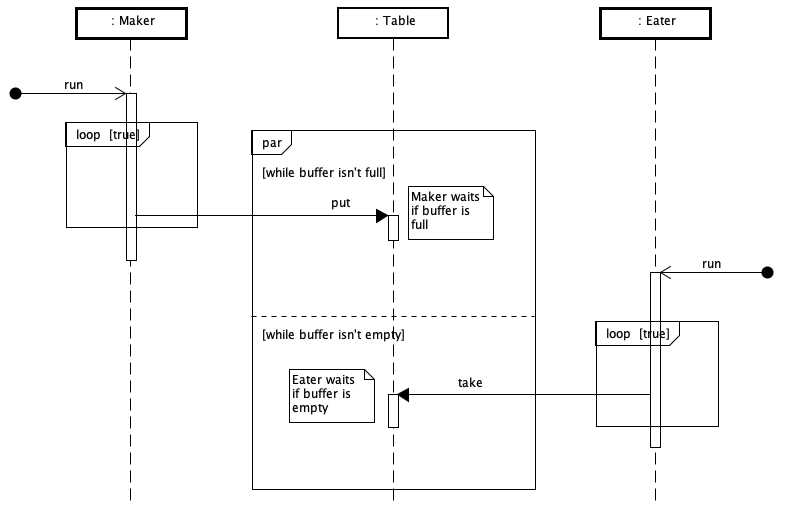多线程程序设计(五)——Producer-Consumer
本文摘要了《Java多线程设计模式》一书中提及的 Producer-Consumer 模式的适用场景,并针对书中例子(若干名称有微调)给出一份 C++ 参考实现及其 UML 逻辑图,也列出与之相关的模式。
◆ 适用场景
为了匹配数据的生产者(Producer)线程与消费者(Consumer)线程之间的处理速度。提高整体吞吐量(throughput)的同时,并保证数据的安全性。
◆ 解决方案
在 Producer 与 Consumer 线程之间加上一个可存放多条数据的缓冲。使用 std::mutex 锁机制保证对缓冲的临界区的互斥访问;使用 std::condition_variable 对象让线程等待至缓冲区可访问,并在可访问后唤醒在等待中的线程。
◆ 参考实现
例子模拟了厨师把做好的蛋糕给食客吃过程。厨师(Maker)把做好的蛋糕放在桌子(Table)上,食客(Eater)从桌上拿蛋糕吃。桌上最多放 3 块蛋糕,如果桌上还有 3 块蛋糕,厨师要等到桌上有空后才能接着放;如果桌上没有蛋糕了,食客要等到桌上有蛋糕后才能接着拿。
class Table
{
...
vector<string>
__buffer__; #1
int
const
__capacity__;
int
__head__;
int
__tail__;
int
__count__;
mutex
__mtx__;
condition_variable
__cv__;
...
void
put(string cake, string name)
{
unique_lock<mutex> lk(__mtx__);
std::printf("%s puts %s\n", name.c_str(), cake.c_str());
__cv__.wait(lk, #3
[&] {
bool full = __count__ == __capacity__; #2
if (full)
std::printf("Table is full. %s is waiting...\n", name.c_str());
return !full;
});
__buffer__[__tail__] = cake; #4
__tail__ = (__tail__ + 1) % __capacity__;
++__count__;
__cv__.notify_all(); #5
}
string
take(string name)
{
unique_lock<mutex> lk(__mtx__);
__cv__.wait(lk, #7
[&] {
bool idle = __count__ == 0; #6
if (idle)
std::printf("Table is empty. %s is waiting...\n", name.c_str());
return !idle;
});
string cake(__buffer__[__head__]); #8
__head__ = (__head__ + 1) % __capacity__;
--__count__;
__cv__.notify_all(); #9
std::printf("%s takes %s\n", name.c_str(), cake.c_str());
return cake;
}
};
存放蛋糕(string)的缓冲区(#1)由 Table 管理。做好的蛋糕通过 put 函数被放入缓冲区中。当蛋糕被放到桌上前,要判断缓冲区内是否已满(#2)。如果已放满(full 为 true),做蛋糕的厨师要等待(#3);如果未放满,蛋糕被放入缓冲区后(#4),并会唤醒等待的其他厨师或食客(#5)。缓冲区中的蛋糕通过 take 函数被取出。当蛋糕被取出前,要判断缓冲区内是否还有蛋糕(#6)。如果没有蛋糕(idle 为 true),取蛋糕的食客要等待(#7);如果有蛋糕,蛋糕从缓冲区中被取出(#8),并会唤醒等待的其他厨师或食客(#9)。
class Maker
{
...
string
__name__;
...
void
run(Table & table)
{
while (true) {
std::this_thread::sleep_for(milliseconds(std::rand()%1000));
...
cake += ...
table.put(cake, __name__); #1
}
}
};
class Eater
{
...
string
__name__;
...
void
run(Table & table)
{
while (true) {
string cake = table.take(__name__); #2
std::this_thread::sleep_for(milliseconds(std::rand()%3000));
}
}
};
厨师会在 0 ~ 1 秒时间内,将做好的蛋糕放到桌上(#1)。食客会在 0 ~ 3 秒时间内,将做好的蛋糕从桌上拿走(#2)。
以下类图展现了代码主要逻辑结构,

以下顺序图展现了线程并发中的交互。

◆ 验证测试
笔者在实验环境一中编译代码(-std=c++11)成功后运行可执行文件,
$ g++ -std=c++11 -lpthread producer_consumer.cpp
$ ./a.out
运行结果如下:
...
Table is empty. Eater-1 is waiting...
Table is empty. Eater-2 is waiting...
Table is empty. Eater-3 is waiting...
Maker-3 puts [Cake No.1 by Maker-3]
Eater-1 takes [Cake No.1 by Maker-3]
Table is empty. Eater-2 is waiting...
Table is empty. Eater-3 is waiting...
Maker-2 puts [Cake No.2 by Maker-2]
Eater-2 takes [Cake No.2 by Maker-2]
Table is empty. Eater-3 is waiting...
Maker-3 puts [Cake No.3 by Maker-3]
Eater-3 takes [Cake No.3 by Maker-3]
Table is empty. Eater-2 is waiting...
Maker-1 puts [Cake No.4 by Maker-1]
Eater-2 takes [Cake No.4 by Maker-1]
Maker-1 puts [Cake No.5 by Maker-1]
Maker-3 puts [Cake No.6 by Maker-3]
Maker-2 puts [Cake No.7 by Maker-2]
Maker-3 puts [Cake No.8 by Maker-3]
Table is full. Maker-3 is waiting...
Maker-2 puts [Cake No.9 by Maker-2]
Table is full. Maker-2 is waiting...
Eater-3 takes [Cake No.5 by Maker-1]
Table is full. Maker-2 is waiting...
Maker-1 puts [Cake No.10 by Maker-1]
...
可以看到,当 Table 上没有蛋糕时,食客需要等待;而当 Table 上已放满蛋糕时,厨师需要等待。
◆ 相关模式
- 在缓冲中存取数据的时候,使用了 Guarded Suspension 模式。
- Future 模式在传递返回值时,使用了 Producer-Consumer 模式。
- Worker 模式在传递请求时,使用了 Producer-Consumer 模式。
◆ 最后
完整的代码请参考 [gitee] cnblogs/18795973 。更多模式请参考多线程程序设计。
致《Java多线程设计模式》的作者结城浩。写作中也参考了《C++并发编程实战》中的若干建议,致作者 Anthony Williams 和译者周全等。
受限于作者的水平,读者如发现有任何错误或有疑问之处,请追加评论或发邮件联系 green-pi@qq.com。作者将在收到意见后的第一时间里予以回复。 本文来自博客园,作者:green-cnblogs,转载请注明原文链接:https://www.cnblogs.com/green-cnblogs/p/18795973 谢谢!




 浙公网安备 33010602011771号
浙公网安备 33010602011771号